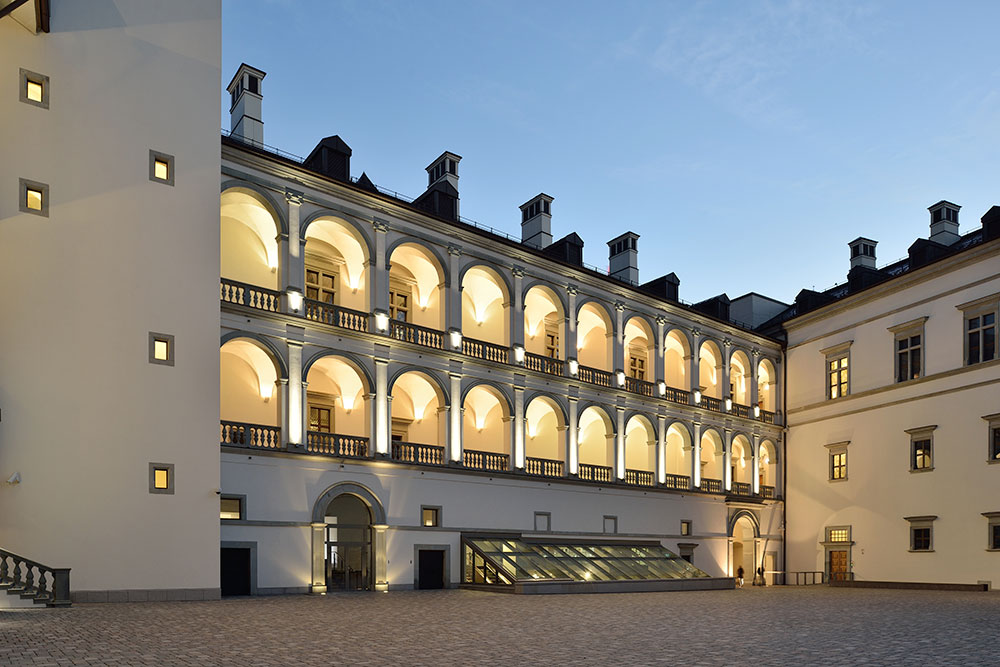
Vilnius Castle of the Grand Dukes. The lower castle in the complex of the castle of the grand dukes in Vilnius
Read more CloseFoto: Nacionalinis muziejus Lietuvos Didžiosios Kunigaikštystės valdovų rūmai/ Nationalmuseum – Palast der Großfürsten von Litauen
In the late Middle Ages, the role of the upper castle in the grand-ducal castle complex at Vilnius decreased while the lower castle flourished. The lower castle was altered and enlarged by the Jagiellons, after they became Grand Dukes of Lithuania and Kings of Poland. Following his marriage to Helen of Moscow, the daughter of the Grand Duke of Moscow Ivan III, Alexander Jagiello, King of Poland-Lithuania, transferred the main residence from the upper to the lower castle and rebuilt the palace in late-Gothic style. Additional building work commissioned by Sigismund I gave the castle its Renaissance appearance. The lower part of the residence was enlarged again following a fire. It was rebuilt in preparation for the coronation of Sigismund August in 1529. Bernadino de Gianotis Zanobi was commissioned with planning the enlargement. Also mentioned in contemporary documents are Bartolomeo Berrecci, Benedykt from Sandomierz and Ulrich Hosse, who supervised the building work.
In 1544, King Sigismund August was invested as governor of Lithuania by his father. Together with his wife, Elisabeth of Austria, he moved to Vilnius. He closed the inner court of the castle and commissioned further work on the castle’s north-western wing, known as the new castle. For these projects the king called Giovanni Cini da Sienna as well as his brother Bartolomeo, Frederik Unstherffe, and Hiob Praÿetfuess to Vilnius. The master carpenter was a certain Marcin from Poland, and numerous artists (including the sculptor Donat from Hungary, Erhard Sweiger and Anton Wiede) decorated the interior.
Unter der Herrschaft des letzten Jagiellonen wurde Vilnius zu einem politischen, administrativen, kulturellen und künstlerischen Zentrum. 1562 fand im Großfürstlichen Schloss in Vilnius die feierliche Vermählung von Katharina Jagiellonica und Johann III., dem späteren König von Schweden, statt. Im Schloss wurden auch bedeutende Kunstwerke sowie Gobelins gesammelt und eine Bibliothek eingerichtet.
During the reign of the last Jagiellon, Vilnius became a political, administrative, cultural, and artistic center. In 1562, the glorious marriage of Catherina Jagiello to Johann III, later king of Sweden, was celebrated at the Grand-Ducal Castle in Vilnius.
The king constructed a library and assembled a large collection of artworks and tapestries, which were housed in the castle. The royal residence at Vilnius closely resembled the residence at Krakow. The common architectural features are clearly evident, and the interiors of both buildings were embellished with similar ornaments and decorative schemes. The piano nobile is located on the castle’s second level in both Krakow and Vilnius.
After Russian invaders destroyed the castle in 1655-61, it remained a ruin. From 1799-1801, it was razed on the order of the Russian government and replaced by a park. In 2000, the Lithuanian parliament decided to rebuild the castle. Two years later, construction began and on June 6th, 2009, the symbolic reopening of the Grand-Ducal castle was celebrated. In 2013 half the castle was opened to visitors.
Lidia Gerc
